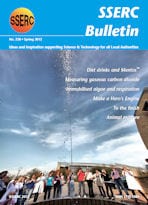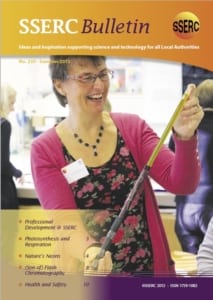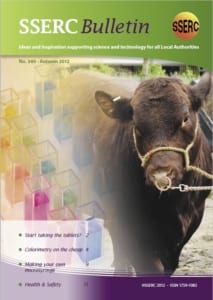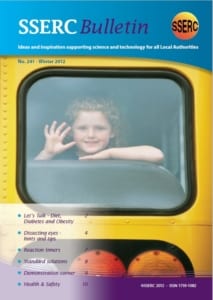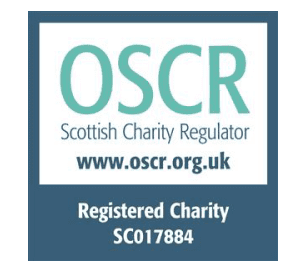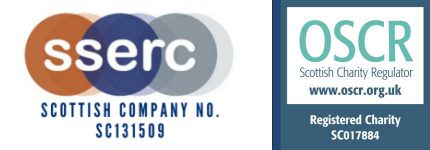A fun fluorescent version of the classic primary school activity .
Measuring gaseous carbon dioxide
In Unit 2 (Metabolism and Survival), part 2 (Maintaining Metabolism) of the Revised Higher in Biology one of the suggested learning activities and approaches is to ‘Investigate metabolic rate using oxygen, carbon dioxide and temperature probes’. The aims of this article are twofold viz (i) to show how gaseous CO2 can be measured in experimental systems, and (ii) to highlight the availability from SSERC, via a loan system, of a set of carbon dioxide sensors.
Immobilised algae and respiration
For studies at Biology National 4 and 5 it is likely that experimental systems involving the use of Elodea and/or Cabomba will be recommended. The Biology Team in SSERC has previously published, in this Bulletin and elsewhere, details of methods involving the aquatic plant Cabomba. Immobilised algae have increasingly been used since details of their preparation and descriptions of appropriate experimental conditions for classroom practicals were first published.
“I’m looking for a simple experiment to show motion from steam production.” On receiving this query, vague memories of coming across an on-line guide to making a Hero’s Engine made from a soft drinks can were stirred (not shaken). We set about checking to see if it actually worked. Having determined that it did, we then assessed whether or not it was safe.
How do you finish mild steel components in your department? Do you remember the days when hot components were immersed in old engine oil to blacken steel surfaces? Oil blackening has associated with it high risk, health and safety hazards. But what are the alternatives – brush or spray painting?
Health and Safety
Over the past few months we have received a number of enquiries relating visits to farms and the use of well-rotted manure in school grounds and gardens. Here is our advice.
Professional Development @ SSERC
For a number of years SSERC has been receiving funding from the Scottish Government to support professional development activities for teachers, student teachers and technicians. We like to think that we are pretty good at what we do and this has been borne out by a recent external evaluation of our CPD provision by the Scottish Council for Research in Education at the University of Glasgow.
Photosynthesis and Respiration
The Biology Team in SSERC has previously published, in this Bulletin and elsewhere, details of methods involving the aquatic plant Cabomba and how these can be used to show the processes of both photosynthesis and respiration. The construction of so-called Cabomba towers can be tricky and may require some practice before reliable results are obtained. We wish to report here a simplified version which overcomes some of the technical obstacles associated with Cabomba towers.
Now that the Arrangements Documents for the Revised and CfE Highers in Biology and Human Biology have been published the Biology Team within SSERC is preparing to publish a series of protocols to support practical work contained therein. Many of these protocols will appear on the SSERC website or in the SSERC Bulletin. The Arrangements Documents all include a suggestion that students might explore ‘Experiments on ATP dependent reactions, e.g. luciferase, luminescent reactions’.
Almost all science teachers are familiar with chromatography in one form or another. Though they differ in many respects, all forms of chromatography work by exploiting different interactions between the dyes and the two components of the chromatography setup.
Health & Safety
Advanced Higher Students & SSERC
We encourage students to work with SSERC on AH investigations. We lend equipment, invite them to our premises and answer queries concerning their practical work. This last area does raise one or two issues concerning safety and child protection. To address these, we ask that certain protocols are observed.
Inductors – the shocking truth
Most physics teachers are familiar with SSERC’s guidance on Van de Graaff generators, most recently updated in Bulletin 223. Recently, we have had a couple of enquiries on shocking pupils with inductor coils, along the lines of, “I’ve been doing this for years, but is it allowed?” The obvious answer is, “If you don’t know, don’t do it until you find out.” Having said that, there seems to be no readily-accessible information available to teachers on whether or not this is a safe thing to do. What is more, pupils may accidentally shock themselves when working with inductors.
The Signs are still a-changin’
Now the shiny new diamond-shaped labels are becoming commonplace in your laboratories, the time has come for an update on the process so far. The next stage is the labelling of ‘mixtures’. This comes into force in June 2015 and existing stock can be sold until June 2017. Until then, the old CHIP labelling system can still be used (though it probably won’t be). This could theoretically lead to the odd situation of the same supplier sending you in the same package copper sulphate labelled according to CLP and copper sulphate solution labelled according to CHIP – quite legally.We answer the following questions:
So where does all this leave teachers and technicians?
What effect will it have on what is taught and how it is taught?
What are we doing at SSERC?
What can you do to help?
Many teachers, and indeed students, own smartphones and tablets. Here we look at some interfacing and analysis applications from two companies associated with datalogging hardware and software – iCelsius temperature probe, Vernier Video Physics and Pasco Airlink.
Colorimetry is simply the measurement of colour. Simple visual colorimetry is familiar to anyone who has been involved with maintenance of a swimming pool and use of the human eye to determine the intensity of a coloured solution is much more accurate than is generally thought: that said, it is not possible to get a really accurate measurement of just how intense a colour is or how cloudy a solution may be.
As a technique of huge importance in chemistry, colorimetry is one of the most widely used methods for quantitative chemical analysis. Unfortunately, it is not used as widely in schools as it should be, largely due to cost. In this article, we will show you how to construct a workable colorimeter for use throughout the school for the cost of only a few pence.
Microsyringes are available from a range of suppliers and can vary in both price and complexity. For measurement of single volumes, we find the range of Volac Minipipets from NCBE is particularly useful – allowing reliable measurement of volumes of 5 μl, 10 μL, 20 μl, 25 μl, 50 μl and 100 μl, although at a price of £16 per syringe class sets might be difficult to obtain. NCBE also provide packs of microsyringes which are suitable for measuring volumes as small as 2 μl and 5 μl when using graduated tips.
In this short paper we wish to show you how you can make your own perfectly serviceable microsyringe capable of measuring volumes from 10 μl to 200 μl in 10 μl increments; the cost of 10 such syringes is approximately £2.00.
Health and Safety
Within SSERC we have received a number of enquiries recently about health and safety concerns about the dissection of animal materials both in terms of what is permissible and where such materials can be sourced. In particular we regularly receive enquiries about dissection of bulls’ eyes. Information on complying with legislation that includes the dissection of bulls’ eyes in schools is contained within the document Materials of Living Origin. As a result of recent changes in legislation the Code of Practice Materials of Living Origin has been reviewed and updated copies will be sent to all Member schools in the autumn term of 2012.
Codes of Practice (3rd editions published)
Safety in Microbiology – Since working with micro-organisms is covered by the Control of Substances Hazardous to Health (COSHH) regulations, it is necessary to have suitable and sufficient control measures in place which have been developed as a result of assessing the risks involved.
Materials of Living Origin – Education uses – Along with the belief that the use of material of living origin in schools can considerably enhance children’s educational experience, for any educational application of living materials to be justifiable, it has to bring with it strong and positive educational benefits.
Let’s Talk – Diet, Diabetes and Obesity
Like many areas of the UK, Scotland is experiencing a dramatic increase in obesity and the related health issues which arise from some members of our population being overweight. The increase in the number of people who have Type 2 diabetes correlates to this increase in obesity and the overall trend has been likened to an epidemic. This discussion activity allows the scientific and societal issues to be explored.
Dissecting eyes – hints and tips
Hands on activities such as carrying out an eye dissection are extremely engaging and exciting for learners. Even a demonstration carried out by their teacher can bring the most attractive illustrations of the eye to life for learners and aid their understanding of its anatomy and physiology. In our view, it is a pity that many teachers and science departments have shied away from carrying out eye dissections with their classes in the belief that ‘eyes are banned’.
Three years ago, SSERC teamed up with Elaine Lorimer from Renfrewshire Road Safety to look at ways of teaching forces in the context of road safety. The result was a reaction timer designed with the help of Fifex and subsequently manufactured by that company.
When carrying out any quantitative work in chemistry, it is important to know the concentration of any solutions you use. Too great a concentration and some reactions will become dangerous, too low a concentration and some reactions will not work.
Demonstration corner – The Whoosh Bottle
This is a tremendous demonstration from the RSC showing the exothermic nature of the combustion of alcohol. It looks particularly spectacular in a darkened room.
Health and Safety
There are standards on performance; there are standards on safety. This is the story of the making of a safety standard for electrical apparatus for school laboratories. (The story is told from a personal perspective.) It covers most things electrical – ovens, fridges, heating mantles, centrifuges, power supplies, oscilloscopes and multimeters – and all manner of hazards – heat, fire, explosion, noise, radiation, cuts and bruises, scalding and electrocution. Exceptions are IT equipment and plugtop devices. Furthermore, the standard relates to the special needs of infants aged 3 and above, children in primary and secondary schools, and young persons aged up to 18 in educational laboratories.
Now the new website (www.sserc.org.uk) is up and running, the long process has begun of updating the hazardous chemicals section to bring it in line with CLP/GHS.
It’s always worthwhile frequently going back to www.hse.gov.uk. A search for ‘wood’ currently reveals downloadable files including a very useful poster on the circular saw. On the website, search ‘wood’. Next, select ‘Health & Safety in the Woodworking Industry’ then look under ‘Resources’.

